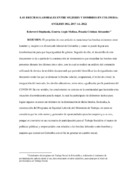Las brechas laborales entre mujeres y hombres en Colombia: Análisis del 2017 al 2022
Resumen
El propósito de este artículo es mencionar las brechas existentes entre hombres y mujeres en el mercado laboral de Colombia y como se puede lograr una transformación para que haya igualdad de género. Seguido de ello, el desarrollo de este documento se da a partir de la construcción de instrumentos que recopilan las brechas más presentes durante los últimos cinco años, con lo cual se realizó un análisis del contenido utilizando la técnica de revisión documental que permitió identificar las desigualdades más frecuentes entre las que se destacan la brecha salarial, ocupacional, el techo de cristal, la integración del mercado, los niveles educativos, entre otras, agudizadas por la pandemia del COVID-19. En ese sentido, las conclusiones se centran en la continuidad que ha tenido esta situación discriminatoria para la mujer, la cual ha participado de diferentes luchas para lograr algunos avances en términos de la disminución de dicha brecha. Se resalta, la construcción del Programa de Equidad Laboral, del Ministerio de Trabajo, en tanto se considera que ha sido motor y generador de oportunidades para las mujeres y a su vez, porque se convierte en un escenario de participación para el Trabajo Social en el marco de políticas públicas y empresariales con relación a las brechas laborales entre hombres y mujeres que existen en Colombia con el fin de generar un cambio social.
Abstract
The purpose of this article is to mention the existing gaps between men and women in the Colombian labor market and how a transformation can be achieved so that there is gender equality. Following this, the development of this document is based on the construction of instruments that compile the most present gaps during the last five years, with which an analysis of the content was carried out using the documentary review technique, which allowed identifying the most frequent inequalities, among which stand out, the wage gap, occupational gap, the glass ceiling, market integration, educational levels, among others, exacerbated by the COVID-19 pandemic. In this sense, the conclusions focus on the continuity that this discriminatory situation has had for women, who have participated in different struggles to achieve some progress in terms of reducing said gap. The construction of the Labor Equity Program of the Ministry of Labor is highlighted, insofar as it is considered that it has been the engine that has generated greater opportunities for women and, in turn, because it becomes a participation scenario for Social Work within the framework of public and business policies in relation to the labor gaps between men and women that exist in Colombia in order to generate social change.
Colecciones
- Trabajo social [101]

